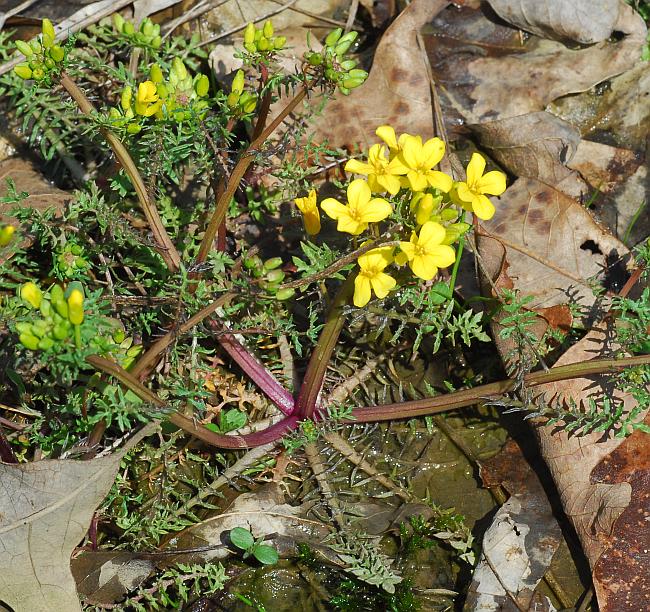Selenia aurea Nutt.
Golden Selenia

Native
CC = 6
CW = 5
MOC = 15
© SRTurner
Selenia aurea Nutt.Golden Selenia | |
 |
Native CC = 6 CW = 5 MOC = 15 |
© SRTurner |
|
Family - Brassicaceae Habit - Taprooted annual forb. Stems - Ascending to erect, to 30 cm, glabrous, sometimes multiple from base, fragrant.
Leaves - Basal and alternate, 2-6 cm long. Basal leaves short-petiolate, the stem leaves sessile, the bases not clasping the stem, the blades oblanceolate to broadly elliptic in outline, pinnately divided into 5-29 narrow, entire or toothed lobes.
Inflorescence - Terminal racemes, compact in flower, elongating in fruit to +7cm long. Pedicels to 2.5 cm long (in flower), glabrous. Flowers subtended by reduced leaflike bracts.
Flowers - Sepals 4, 4-6 mm long, narrowly oblong to ovate, spreading to erect, greenish becoming yellow, glabrous. Petals 4, 8-11 mm long, not lobed, yellow. Styles 5-10 mm long. Stamens 6, erect, subtended by small green nectaries. Filaments to 6 mm long, yellow, glabrous. Anthers 1.2 mm long, yellow-orange. Ovary on small gynophore (to 1 mm long), 3 mm long, glabrous, green, narrowly ovoid. Style to 4 mm long, greenish-yellow.
Fruits - Siliques, beaked by persistent style, glabrous, borne erect or ascending, light green with darker margins, 10-25 mm long, oblong or elliptic, less than 2 times as long as wide, flattened parallel to the septum, the margins entire to slightly wavy, dehiscing longitudinally, the valves lacking midnerves, the stalk 1.0-2.5 cm long. Seeds 6-12 per fruit, in 2 rows in each locule, 2.7-3.1 mm long, circular in outline or nearly so, flattened, the margins broadly winged, the surface with a netlike or honeycomb-like pattern of ridges and pits, orange.
Flowering - April - May. Habitat - Glades, rocky prairies, open disturbed areas on chert or sandstone. Origin - Native to U.S. Lookalikes - None. Other info. - This small but striking species can be found in a handful of southwestern Missouri counties. Elsewhere its distribution is almost entirely limited to the three states to the south and west of Missouri. The plant can be found in large colonies and the brilliant yellow flowers light up their glade habitat. The plant is easy to identify in the field because of its distinctive pinnatifid leaves and striking flowers. Selenia aurea would make a magnificent garden subject if the right conditions were provided. Photographs taken on Lichen Glade, St. Clair County, MO., 4-3-04 (DETenaglia); also at Wildcat Glade, Newton County, MO, 4-14-2013, and at Corry Branch Glade, Dade County, MO, 4-6-2019 (SRTurner). |